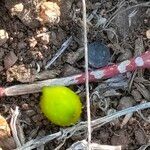Plants: rootstock thick, woody. Tendrils antrorsely strigose. Leaves: petiole proximally retrorsely strigose, medially hirsute, distally antrorsely strigose; blade ovate, palmately 5-lobed, 2.5–9(–16) × 2–8.5(–13) cm, length 0.8–1.2 times width, base cordate to subcordate, lobes elliptic, margins serrate. Inflorescences: pedicels of pistillate flowers and fruits cylindric; staminate flowers 1 or 2–6 in sessile fascicles or panicles; pistillate flowers: calyx lobes 1.5–4.5 mm, petals 2–7 mm, corolla tube 0.3–1.2 mm, puberulent to sparsely puberulent inside. Pepos orange to yellow with green to yellow stripes, monocolor or bicolor-striped at maturity, short-ellipsoid to globose, 1.5–3(–5) × 1.5–3 cm, obscurely aculeate, flesh yellowish. 2n = 24.
Annual; stems to 2 m long, hispid. Leaves broadly ovate, cordate at base; lamina 25–75 mm long, 25–80 mm wide, 3–5-lobed; lobes obovate, dentate to lobulate, obtuse, apiculate, almost glabrous above, hispid beneath; petiole 10–85 mm long, hispid. Male flowers in 2–4-flowered fascicles or short racemes; peduncle to 5 mm long; pedicels 2–4 mm long; hypanthium campanulate, 3 mm long; calyx lobes subulate, 1.5 mm long; corolla lobes ovate, 4–5 mm long. Female flowers solitary or paired; pedicels 3–8 mm long; ovary ellipsoidal, attenuate, 2–3 mm long, setose. Fruit subglobose, 15–25 mm diam., with scattered soft bristles, green with pale longitudinal stripes, ripening yellow; pedicel 6–25 mm long. Seeds 3–4 mm long.
A herb. It is an annual plant in the pumpkin family. It grows 20 cm high and spreads 5 m wide. The stem lies along the ground and has tendrils. The leaves are oval or heart shaped and 6 cm long. There are 5 leaflets with teeth along the edges The flowers are white with dark green stripes. The flowers occur in clusters or 2 to 4. The fruit are pale green oval melons that turn yellow when ripe. They are 2-3 cm across. There are many fruit hidden under the leaves.
Monoecious, roughly hairy, poisonous annual, with prostrate stems, up to 2.5 m long, and with simple tendrils. Leaves broadly ovate, up to 160 mm long, deeply palmately 5-lobed. Flowers up to 8.5 mm long, yellow, male 1-6 per axil, female solitary. Ripe fruit ellipsoidal or globose, 15-50 mm long, sparsely to densely prickly, longitudinally striped in shades of orange or uniform pale yellow.



